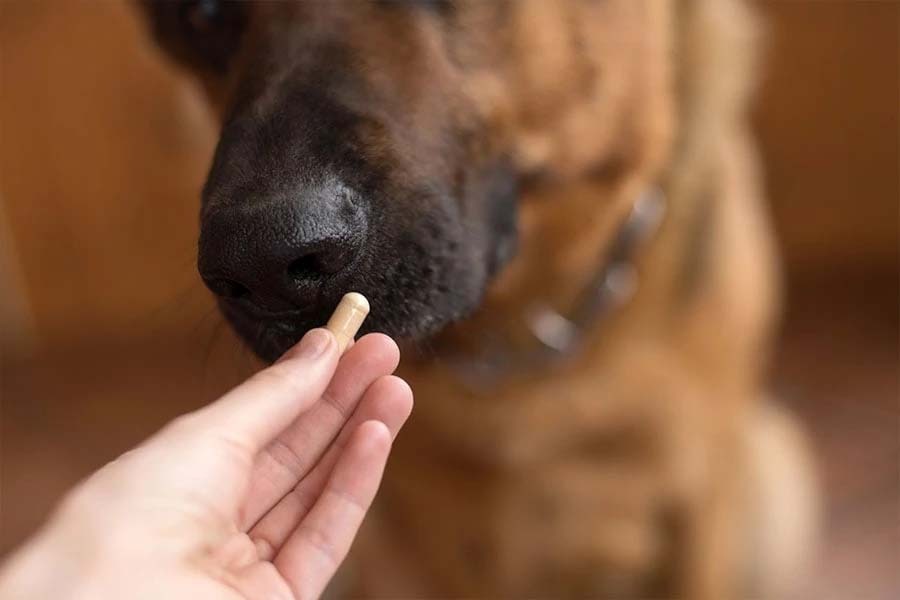A Turramurra Vet Pet Behaviour Article
Is Giving your Dog Oral Medication a Struggle? Let’s Make it Easier.

Is Giving your Dog Oral Medication a Struggle? Let’s Make it Easier.
by Katie Bedrossian, Pet Behaviour Consultant
When it comes to giving oral medication to your dog, is it easy or difficult? Are they a hide and flick it out type? The clamp the jaw shut type? Or the wriggly worm type? Whatever your dog’s avoidance technique might be, there are some ways to ensure it is a one and done deal without any of the struggle.
First, check if the medication is a flavoured medication (e.g. beef or pork) or a palatable chew. If so, we can give it as a treat. But what if your dog’s nose knows better and he or she won’t take it as a treat? See below for some tips on delivery to improve success of consumption.
Second, check if it is meant to be given with or without food. This can affect your dog’s gastrointestinal tolerance to the medication as well as the absorption (some need food with the medication to aid this, others need an empty stomach for the same thing to occur).
If the medication is to be given with a full meal, it is best to give the medication first, and then follow with the meal, as this way you ensure the whole medication gets consumed and your dog doesn’t simply eat around it.
How to give a flavoured tablet or chew like a treat!
Step 1
First, ensure no other dogs are around and you can access the floor near your dog. Instead of handing the medication directly from your hand to their mouth, as soon as your dog has a curious interest in the medication, wave your hand back and forth (enough movement for your dog to see it as a game, but not too fast that your dog loses interest), then toss it on the ground. Many dogs will eat it, as it is now a game of chase and not just about the medication. You can improve the chances by doing this at a time you normally do training with treats, such as exercise, treat, exercise, treat, medication game, exercise, treat. So, give them a real treat the first couple of times, then cunningly replace the treat with the medication, then return to the real treat.
If step one is unsuccessful, move to Step 2 below.
Step 2
Take 3 small portions of a high value soft or moist food (a 2cm cube of moist or semi-moist food or a teaspoon of soft food). Prepare the 3 small portions on a tray or mat. Only put the medication in 1 of them, so 2 are just treat foods and 1 has the medication hidden inside the treat food. Ideally, have one person place their hands on your dog’s chest and hold your dog back while the other person puts the food down. Not a sit and wait, but someone restraining them (as gentle pressure on their chest away from the food increases value in the food when released). Now release your dog. This works much better than medication hidden in a single treat given by hand. To improve your chances of this working, do this initially as a game where there is no medication in any of the food portions.
How to give medication that needs to be given on an empty stomach or bitter-tasting tablets
When you need to administer bitter-tasting tablets, avoid using Steps 1 or 2 above because this will quickly create a negative association to the above methods.
It is good to practise this with just treats as rewards, so that your dog associates it with a positive experience.
- Use a high value treat (one that your dog finds irresistible that is rarely received)
- We need to use the treat right near your dog’s nose to lure them into a sitting position facing away from you. Don’t use the word ‘sit’ as this sit position is unusual for them and not connected to the word ‘sit’. For big dogs we want to be in a corner with our legs on either side of them. For small to medium-sized dogs, kneeling on the floor (sitting back on your feet) with them between your legs is ideal (alternatively, they can be on a table with a non-slip mat).
- Have as much of your body in gentle contact with your dog as possible (enough to make them close, but not restrained and in panic mode).
- Coming from behind, put your non-dominant hand onto your dog’s upper jaw. Place your thumb and forefinger on either side of the muzzle as close to the corners of the mouth as possible (with bigger dogs and/or smaller hands, your fingers will be further away, but aiming towards that direction). Gently raise your dog’s head up slightly. With your dominant hand and the tablet between your thumb and forefinger ready to go, use your other fingers to gently lower the bottom jaw. As you put the tablet in, aim it for the middle of the tongue and as far back as possible. Your hands will get saliva on them if you give the tablet correctly. Hold the mouth gently closed and encourage your dog to swallow if they are not currently. This can be done by gently rubbing the throat.
- If the medication is bitter-tasting, but fine to be given with food, you can give a treat, followed by the tablet, then followed by another treat. The best treat for afterwards is some soft food, yoghurt, vegemite or peanut butter on a licky mat as the licking encourages more swallowing.
If you purchase your medication from us (whether prescription or over-the-counter) please don’t hesitate to ask for a demonstration on how to give oral medications – we can even do the first one for you.
If you are experiencing aggression or anxiety from your dog, for safety reasons, please don’t persist with the above and instead, speak to our veterinarians for their recommendation for your dog. For super wriggly dogs, we recommend a behavioural consultation with our Pet Behaviour Consultant, Katie Bedrossian, to increase positive handling skills for your dog.

